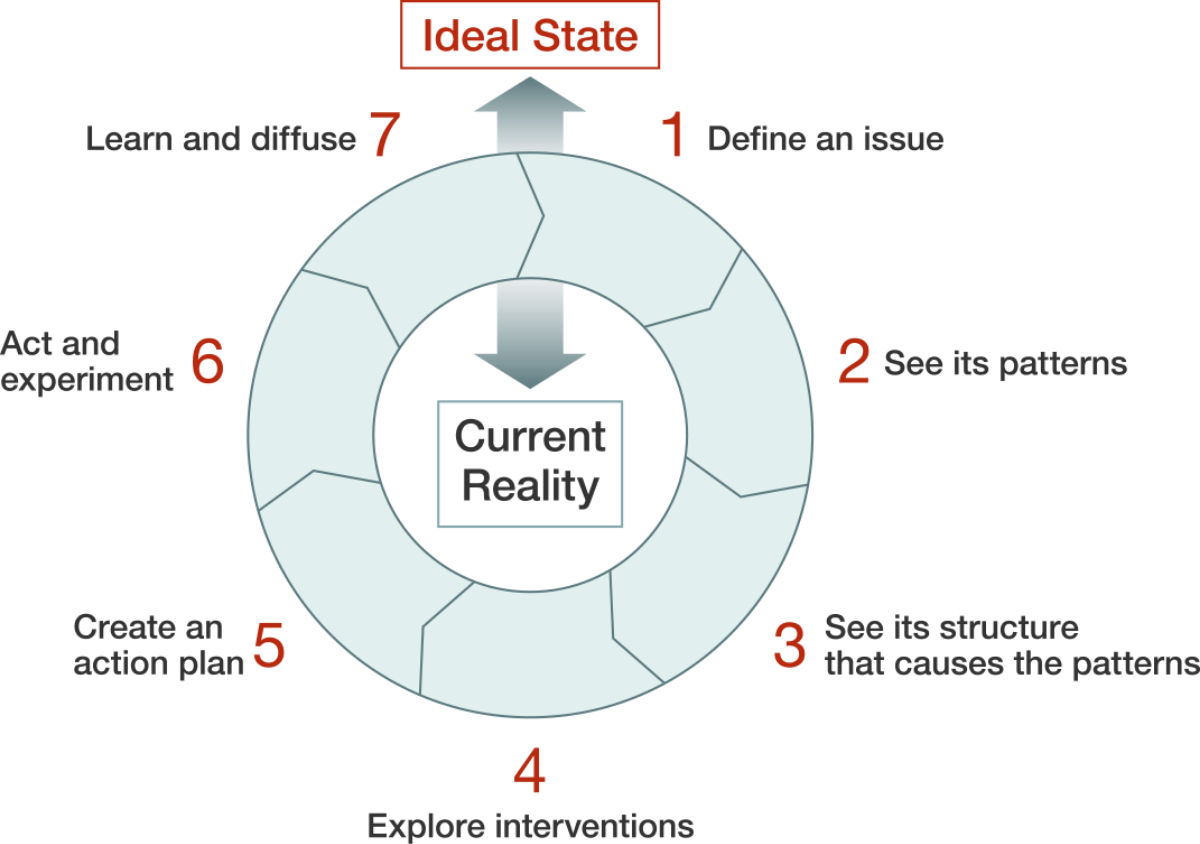Systems thinking
Systems thinking process

1Define an issue
Systems thinking is a multifaceted, holistic process that can spread indefinitely or become difficult to collect unless you first set a task. On the other hand, if you do not leave the familiar shore, you will not find a new continent. Before you start your voyage through the ocean, you should have a solid reason why you are going on that voyage, identify the challenges, and if you have a large crew, make a tentative plan in advance. Discuss and write down what you are trying to understand or what your vision is. (If you go to the next step and find that the assignment is incorrect, you should always go back and re-design.)
2See its patterns
Whether or not there are results, whether or not problems are occurring, etc., we tend to be fascinated by the level of events. On the other hand, we tend to unexpectedly neglected the big picture such as what kind of progress is accumulated and what is happening in the world around it. After defining an issue, it is important to observe what is happening around it and examine it as much as possible. If there are any ambiguities, contradictions, or situations that aren't straightforward, they can be a clue to the big picture of the system. In this step, you usually interview the people involved or go to the scene for observation. Based on the interviews, photos, videos, etc., gotten, tools such as "Time Series Change Pattern Graph" could be used to understand what is happening as a dynamic process, not as a snapshot. Systems thinking is also a process that is closely related to the design of indicators such as "key performance indicators (KPI)", "Balanced Scorecard" and "(social) impact analysis".
3See its structure that causes the patterns
"Why does the system behave that way?" The most important principle of systems thinking is that patterns are structurally influenced. Instead of thinking that it is influenced by an external factor, we repeatedly ask "why" the structural pattern is occurring. While looking at the structure, we should focus and examine it as much as possible, paying particular attention to structural factors and the interactions that occur between the underlying systems, and create a hypothesis that explains why the dynamic pattern is occurring, then perform the model verification. Various modeling tools are used in this step. The easiest to get started with are basic tools such as "loop diagrams" and "systems archetypes". More seriously, "stock & flow diagram", "XY relationship diagram", "system dynamics model" (simulation model), "stakeholder analysis", "scenario analysis", etc., are used.
4Explore interventions
The first phase of the systems thinking process is broadening and deepening the understanding of the system, "why the pattern is occurring as such". Once you have a solid understanding of how the system behaves, explore whether the system should be redesigned and rebuilt for your purpose. This step, also known as "measure analysis" or "alternative strategy analysis," uses concepts such as "entry point analysis," "leverage point," "mental model," "presenting," and "tertiary loop learning," and is essential and sustainable. The aim is to create a unique change.
5Create an action plan
If you are an individual, write down what new actions you should take and how you can create a structure that makes it easier to take those actions. For different departments / organizations, document new insights and vision-based agreements, monitor results that would be involved in later steps, and even take steps to adapt to monitoring the situation.
6Act and experiment
If the work you find in the systems thinking process is a task suitable for an individual or a team, but can be repeated by an experienced manager or team, do not hesitate to take action. You can do it! On the other hand, when you are trying to deal with issues that are often unknown, such as new markets, business fields, and projects, or complex and unique issues that have not yet been realized as civilizations, it is more effective to conduct risk-controlled experiments than to suddenly move to full-scale implementation. The "prototype" phase of design thinking and the "co-realization" phase of Theory U correspond to the "experimental" steps of the systems thinking process.
7Learn and diffuse
Whether it is an intentional experiment or a success or failure of the results of an action, the timing of reflection is set in advance in the action plan. This is because if it is an unexperienced field as a team, it is often possible to understand the behavior of the system for the first time by examining it. We would extract new lessons and update documents such as time series change pattern graphs and loop diagrams. When the system is well understood and the measures are well-developed, we would consider investing more resources and spreading the effect more widely. The organization uses various reflection and learning methods such as "learning lab" and "after-action review" to interweave "learning organization" methods that continuously improve organizational capabilities and systems effectiveness.
For convenience, the explanations are given in order, but when the process is actually run according to discipline, it often returns the process to the previous stage. Also, in fields where there are many unknown aspects and innovation is required, it is often the case that the standard of comprehension is loosened and the learning speed is increased by rotating the cycle quickly and many times. In any case, it is recommended that you first grasp the overall picture of the future creation / learning process through systems thinking, and then learn how to use effective methods and tools at each stage.



